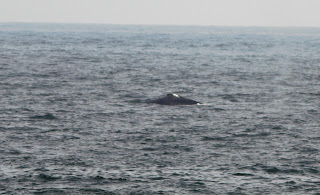Following
our stay at Honeywood Lodge (see here) we headed north-west to Paternoster on
the coast north of Cape Town for a 3-night stay, in another nice
lodging booked through Air Bnb. We travelled via Karoopoort and Ceres
to take in the bottom end of the Karoo ecosystem.
We failed to find Cinnamon-breasted Warbler in a couple of likely looking spots and did not have time to head further north to the main sites for this species. In the karoo and rocky outcrops we saw Karoo Prinia, White-backed Mousebird, Pale-winged Starling and Fairy Flycatcher.
We
also saw a couple of Klipspringer.
Paternoster
is a delightful town with boulder-strewn beaches and buildings
structured around classic Cape Dutch-style architecture.
On
our first morning at Paternoster we drove east to St Helena Bay. In
roadside fields were numerous larks including the western race of
Cape Clapper Lark, a likely split, and plenty of Red-capped Larks and
Large-billed Larks.
Other
birds included White-throated Swallow, Southern Red Bishop, Capped
Wheatear, Familiar Chat and White-throated Swallow.
We failed to find Cinnamon-breasted Warbler in a couple of likely looking spots and did not have time to head further north to the main sites for this species. In the karoo and rocky outcrops we saw Karoo Prinia, White-backed Mousebird, Pale-winged Starling and Fairy Flycatcher.
 |
| Karoo Prinia |
 |
| White-backed Mousebird |
 |
| Klipspringer |
 |
| Coast near Paternoster |
 |
| Paternoster town |
 |
| Large-billed Lark |
 |
| White-throated Swallow |
 |
| Southern Red Bishop |
 |
| Capped Wheatear |
We
caught up with two targets missed on previous trips – Grey Tit and
the diminutive Cape Pendulite-Tit in the strandveld vegetation.
Other
birds in the strandveld included Karoo Scrub-Robin and Chestnut-vented
Tit-Babbler.
Blue
Crane was plentiful in the area and Spotted Thick-knees were about in
areas with open ground.
European Bee-eaters had arrived in numbers for their annual summer visit.
In
the afternoon we visited the Lighthouse Reserve south of Paternoster.
Cape Spurfowl was numerous and White-fronted Plover was on the
beaches in numbers.
Offshore
we saw several fairly distant Southern Right-backed Whales, while
Cape Gannet was plentiful.
Southern
Double-collared Sunbird was common about our lodge. Kelp Gull and Speckled Pigeon were abundant around the town.
Later
in the afternoon I drove along another side road off the
Vredenburg-Paternoster road and succeeded in finding another target –
Cape Long-billed Lark.
The
next day we visited the West Coast National Park, where wildflowers
were in abundance amid a magnificent coastal vista of sweeping
strandveld plains, lagoons and coastal dunes.
At
Seebook Lookout, not far from the park's northern end, we flushed a
male Southern Black Korhaan – another much-wanted South African
endemic – and then a second korhaan. Grey-winged Francolin was also
here.
Yellow
Bishop was an inquisitive visitor at a lunch stop.
We
saw two Black Harriers, surely one of the most impressive raptors,
separately hawking the strandveld.
Around
the lagoons were Greater Flamingo, Lesser Flamingo, Cape Teal,
Kittlitz's Plover and African Marsh-Harrier.
During
our return to Cape Town the following day via the Darling Wildflower
Route, we found a pair of Southern Black Korhann roadside (first
image of this post). We flew to Johannesburg for an overnight stay
before flying home.
 |
| Grey Tit |
 |
| Southern Penduline-Tit |
 |
| Chestnut-vented Tit-Babbler |
 |
| Blue Crane & Sacred Ibis |
 |
| Spotted Thick-knee |
European Bee-eaters had arrived in numbers for their annual summer visit.
 |
| European Bee-eater |
 |
| Cape Spurfowl |
 |
| White-fronted Plover |
 |
| Cape Gannet |
 |
| Southern Right Whale |
 |
| Kelp Gull & Speckled Pigeon |
 |
| Southern Double-collared Sunbird |
 |
| Cape Long-billed Lark |
 |
| West Coast National Park |
 |
| West Coast National Park |
 |
| West Coast National Park |
 |
| West Coast National Park |
 |
| Southern Black Korhaan |
 |
| Yellow Bishop |
 |
| Black Harrier |
 |
| Cape Teal |
 |
| Greater Flamingo |
 |
| Kittlitz's Plover |

No comments:
Post a Comment